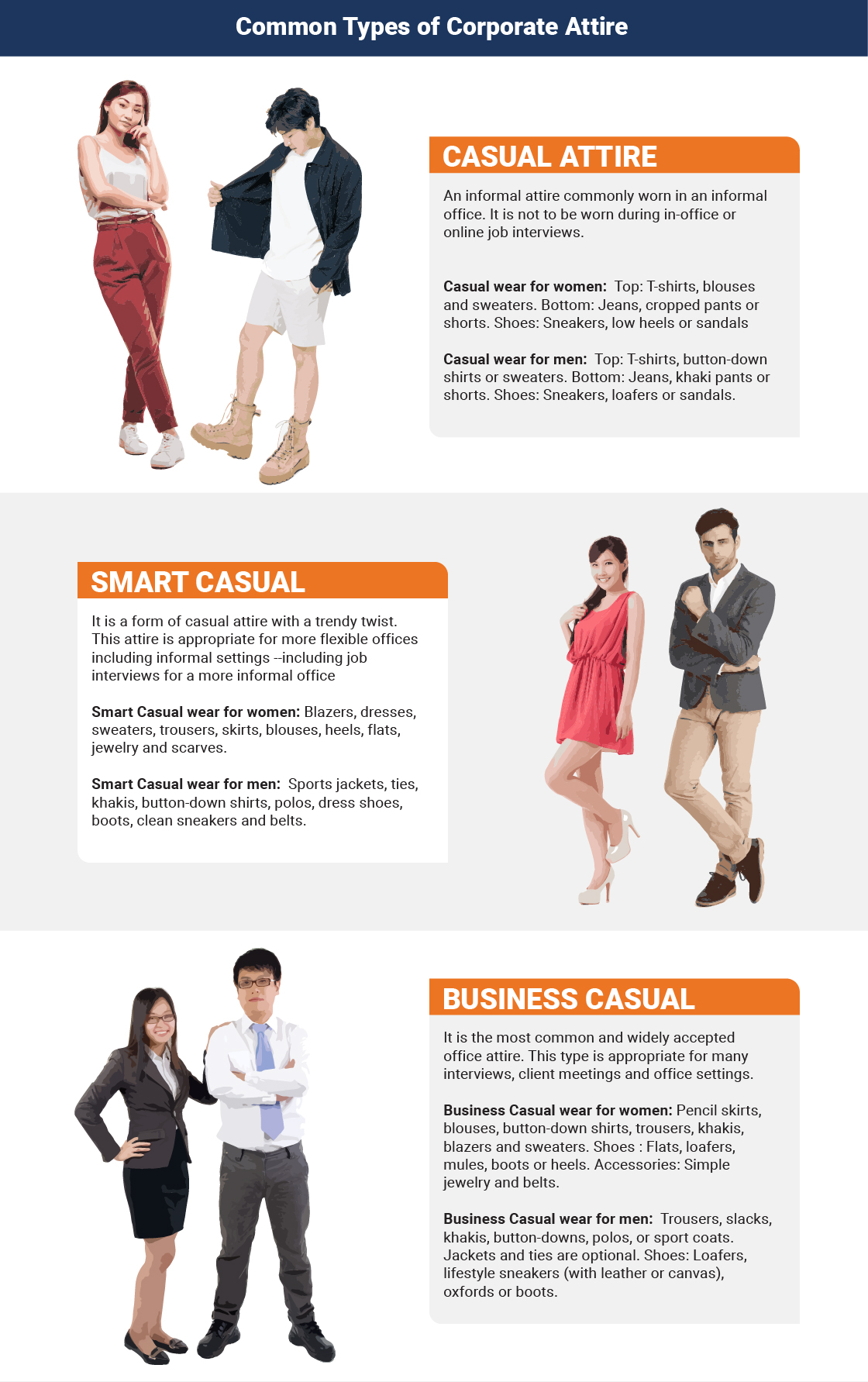(Updated as of July 2021 by Allanah Paragas)
What clothes you wear affects how people view you as a professional. Corporate dressing is all about how you project yourself as a professional through the way you dress and carry yourself in every situation. Being presentable at all times—whether you are at work, attending interviews, or corporate events —can affect your reputation and as well as the company’s image.
Most companies require their employees to wear business casual attire on a daily basis at work. As a professional, your corporate attire highly depends on your role and your work environment. It is up to you to decide which kind of business attire is appropriate.
But remember, the way you dress can also contribute to your success. According to Giorgio Armani, an Italian designer, “Elegance is not standing out, but being remembered.” Your corporate attire should be well-thought off. It should be a combination of how you want others to perceive you professionally and what organization you are representing. Wear clothes that will make people remember you and your profession.
In this article, you will have a better understanding of how you can better groom and dress at work and in almost all office-related situations.
General rules or etiquette in corporate dressing and grooming:
For all professionals:
- Whether you are new or an ongoing, you should appear composed and professional.
- Dress appropriately to make a positive first impression.
- Ask the HR team or your manager about dress codes policies at work.
- Avoid clothing with offensive images or language, and even affiliations or other logos that may appear unprofessional in the workplace.
For male professionals:
- Always be neat and clean including your teeth, fingernails, face, hair, and even your shoes.
- Invest in business suits in basic colors.
- Wear wrinkle-free and subtle or neutral-colored shirts, and well-fit trousers (in black, blue, or grey color)
- Wear a mild-scented cologne or perfume.
- Minimize your wearing of too much jewelry.
For female professionals:
- Ensure your hairstyle is neat and conservative and preferably does not cover your face.
- Wear flats, or if you prefer heels choose the ones with three inches or less.
- Wear simple and appropriate make-up for the daytime.
- Nails should be clean and trimmed or sculpted.
- Wear a mild-scented cologne or perfume.
- Wear minimal accessories and jewelry.
What are the different types of corporate attires?
There are different types of corporate attires and each type varies on the situation. Depending on the setting, you can choose the appropriate clothes ranging from casual to business formal. Here’s a guide you can use to know the common types of corporate attire and what clothes to wear:
(If you are using mobile, you can zoom in the photo)


What is the appropriate corporate dressing style?
The most basic style is the business casual attire or the wearing of button-downs and trousers for men, and wearing of blouses and pencil skirts for women across job roles and functions. The idea behind this style is it’s a blend of the business professional attire with a more relaxed and comfortable style.
(If you are using mobile, you can zoom in the photo)

What should I wear on my first week at work?
Prior to your first week at work, you can ask the HR team on what would be the best attire to wear, and this largely depends on the corporate culture and industry you’re in.
On your first day at work, pay close attention to the way people dress so you take inspiration from their fashion cues and add your own personality. In case of doubt, overdressing is better than being underdressed.
What should I wear if I have important meetings?
You need to dress up according to the people who will attend the meeting and also based on the venue. If you are going to meet high-profile clients or C-level officers in a conference room or any close-door venue, it would be best to wear the classic suit and heels.
If you will talk or present to a team of engineers outdoors, it would be better to stay away from suits or tight-fitting clothing and choose to wear smart casual polo shirts instead.
If you are unsure of the setting, wear your business casual attire.
Wearing the right corporate attire comes with carrying a good amount of your self-confidence with you. Remember, being part of a meeting means you will collaborate with the people. It’s best to bring your best self and be involved in business matters.
What is corporate dressing? How does it differ from corporate attire?
According to managementstudyguide.com, corporate dressing is “the act of dressing formally and correctly” in line with your job profile and with the company’s culture.
Corporate attire is synonymous with business attire. It is the type of clothing you wear as a professional. Your corporate attire varies depending on the situation you are in and the type of office you work in.
Why is corporate dressing important? Does is still matter today?
The way you dress affects how people see you and is important because you represent the organization. Corporate dressing still matters today and is important because:
- It can help you attract people—especially clients or customers you are targeting to close deals with.
- It can empower you by boosting your self-confidence.
- It helps create a good first impression and in the long run, has a great impact on your career.
What should I wear during online job interviews?
Prior to the pandemic, in-office job interviews require the job candidates to wear business professional attire—well-fitted and may be tailored to fit you.
Currently, most companies are still conducting online job interviews versus in-person, and this may still be the trend moving forward. Online interviews do not only require you to prepare the right attire but also the right setup, which includes the right interview spot, the video platform, the interview format, etc. It is highly advisable that you wear a business professional attire or a business casual that will look good on screen and against the background you will be using.
What should I wear if I am working from home?

The way you dress while on a WFH setup depends on your role, the company culture, and the industry:
- As a general rule of thumb, looking professional from your hair, face, and top/shirts are the focal points to consider when your day requires online meetings and interactions.
- On the other hand, your attire is entire to your liking if your day requires an independent or solitary type of work (without online video interactions).
Only you can decide on how dressing empowers you to conquer your day. To some, comfort and practicality help them with work that entails “rolling-up-your-sleeves” like writing, coding, researching, designing, crunching data on Excel, etc.
Nevertheless, dressing also acts as a subconscious prompt to others, which is why some companies have uniforms and strict dress codes (think of doctors on duty with lab coats or a judge in a black robe). When you put on a piece of clothing, it signals your mind and body that you are in “work mode.” Because of being at home most of the time, it also helps others make the distinction or segregation between time to work, leisure, and bedtime.
What should I wear when I return to office for work?
Dress codes post-COVID will highly depend on the organization’s policies. It’s advisable to talk to your manager or the company’s HR team to know what attire is accepted in the organization.







